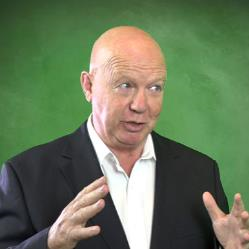
"How to have the challenger conversation" - interview by John Smibert.
 In this discussion Dean Kelly provides us with advice on how to conduct the conversation with your customer where you challenge them without sounding arrogant or aggressive.
In this discussion Dean Kelly provides us with advice on how to conduct the conversation with your customer where you challenge them without sounding arrogant or aggressive.
There's a lot of talk about what 'Challenger' is and what you've got to do. Dean claims that there are very few people who talk about how you actually do it.
He acknowledges that many salespeople do not have a challenger personality type where they find it easy to diplomatically challenge the client, and not overstep the mark or offend. So to help them challenge their customer in an effective and constructive conversation he provides simple advice - and an associated tool.
See the full interview below to learn more.
Dean Kelly is the Sales Deal Mechanic.
Interview:
John: Welcome back! I've got Dean Kelly with me again, the deal mechanic! Welcome back, Dean!
Dean: Thank you, John!
John: Hey Dean, we've had some good discussions about value, and value life cycle for customers and so on.
Dean: Yes.
John: I'm interested in the actual conversation that salespeople need to have with their customers. And what I'm thinking about, I'm thinking these days a lot about 'Challenger', and the whole concept of challenging the customer. Could you talk about how you think that sales conversation should occur?
Dean: Certainly. There's a lot of talk on the market about 'Challenger', and there's a lot of talk about what 'Challenger' is and what you've got to do. Very few people talk about how you actually do it.
John: Right.
Dean: In the context of the value life cycle, there's a very clear methodology on how. One of the things that I think that salespeople need to be aware of is that not all of us are a "challenger" personality type.
John: That's true.
Dean: And therefore, if you're not a challenger personality then how do you have the conversation where you're diplomatically challenging the client, but not overstepping the mark and not being in any way arrogant or aggressive. It's a very tough determining how you have that conversation.
John: So, how do you do it?
Dean: A couple of things that I use is first of all, if you're looking to get a complex deal, a multifaceted deal into a dialogue with a client, how effective will you be if you merely use words? You know, we're doing a video here; when words come out of my mouth - or your mouth - they dissolve. And so if you don't write them down you're not going to take advantage of them. When I've got a deal that has 'cost of ownership' - and ROI - and people and resources, and all these; I've got multiple facets that I'm trying to juggle and keep in the conversation. Well, I can't do that with words. And if the client goes off in a different direction, how do I get them back and say "Well, here's where we are." So, a picture is probably the simplest way of doing this.
John: What sort of picture?
Dean: Having a picture which has maybe some circles or squares, or, you know, I call it a bubble chart, where you have a bubble chart that has got a number of the facets of the customers business displayed. It's in an easy-to-read format, so you can draw the client's attention, and rather than presenting it you use it as a tool for asking questions.
NOTE: Would you like an example of Dean's bubble chart - register (free) and then click here - Download the Bubble Chart example.
John: And the customer helps you fill in the bubbles?
Dean: Well, they can. Or, you can come with them pre-filled in, because you have an idea of where you want to steer the conversation. But you'll have a few blank ones that say "Mr. Customer, I don't know all about your business, so you help me understand what I'm missing."
John: But in the first discussion you and I had, you were saying that it's very important that you get the customer express the value and not us express what we think the value is to the customer. If you've already got the bubble chart filled in, is that...
Dean: Two things. One, it's never 100% right, and you don't want it to be. And you've always got some blank bubbles.
John: Okay.
Dean: Think of it this way: I come to talk to John. Now, I've done some research on your business, like a good salesperson has, so I know already what's published about your business initiatives or your business imperatives; I'm going to have that maybe at the top, and your logo is on the picture. Then I'm going to say "John, which of these are the critical imperatives that you have to resolve in a short space of time?" and you'll start giving me feedback. Now, what I'm having in this conversation is like a game of badminton. As quickly as I can I've got to get the shuttlecock on your side of the net and you involved in the conversation. Now, that conversation's very different from show up and throw with 400 slides where I'm talking at you.
John: Sure.
Dean: So, this is about breaking that monotony and getting you involved. Then I'm going to say "Well, John, I don't know your business, but in working with other clients with very similar problems they've told us that some of these items are very important to them. As you look at this from your business perspective, what have I missed? What needs to be added?" I'm giving you the opportunity to now say "Well, Dean, you missed it here, or we'd add this one." So, it's now a conversation, rather than a one-way dialogue.
John: And you're positioning yourself as a domain expert too. You've actually got all this knowledge you're bringing to the table, and adding it to the conversation.
Dean: Please be serious. How many times has a customer implemented a solution like this, whatever the solution is? They've done it once or twice!
John: And as a salesperson, you've been involved many times!
Dean: Well, and I've got clients around the world, or my organisation has many clients, we've done this thousands of times. So, who actually knows what a good solution looks like? Who knows what the outcomes the client should be seeking. Well, we actually do, so let's bring it to the client...
John: But not tell them.
Dean: Correct. It's not telling them "This is the way!" and you're saying "You've got to do it our way!" because that's not good enough. It's saying "My experience is these are things that are important, that other clients have said. How do you feel about it? What have I missed? What do you believe for your organisation should be added?"
John: "Where are you different?" Everybody's different.
Dean: And then the next question-so, the first question is "What have I missed? What do you believe should be added?" The next question is "John, as you think about your business, what would be your top three, and why?"
John: Right.
Dean: Because I now need you fully engaged "This one, this one..."
John: Yes, to prioritize it.
Dean: And when you pick those top three, or the first three, I need to know the why. Now I'm asking you the value "How do you do that today? Well, that's interesting. How long does that take? If you could speed that up, how much improvement would you like?" So I'm now in the conversation, to get the chips on the table.
John: And the customer is expressing the value.
Dean: Indeed.
John: Okay. Great approach, I like a lot of what you're saying, and I'm looking forward to the next time we talk.
Dean: Thanks, John!
****************
More of Dean Kelly:
***************

Your Invitation: I invite you to join the Sales Leader Forum group on LinkedIn where you can experience informative discussions with your peers and sales thought leaders on subjects like the one we have discussed here. I also invite you to subscribe to the
- Sales Leader Resource Centre here
- Sales Leader YouTube channel here (300+ sales leadership videos)
Please Share: If you valued this article, please share via your Twitter, LinkedIn, Google+ and Facebook social media platforms. I encourage you to join the conversation or ask questions. So feel free to add a comment on this post - I promise to respond. If inclined please follow my LinkedIn post page here.
Want to touch base? If you have questions please feel free to contact me - email: john.smibert(at)salesleaderforums.com, Phone: +61 404857893 or Skype: john.smibert